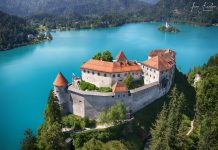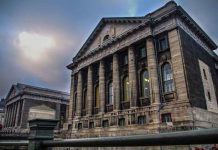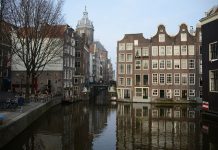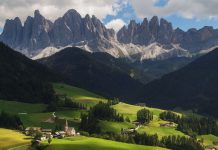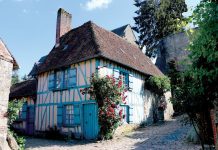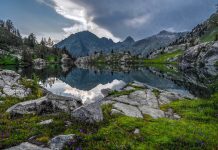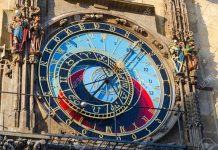The present Iran National Museum complex was built 60 years ago.
The idea for the construction of a building to house and protect the country’s cultural heritage came from Sani od-Doleh. In the year 1295 of the lunar hegira (LH) calendar , a part of the old building of the Ministry of Sciences , located north of the Dar ol-Fonoon Technical School , was allotted for this purpose.
In 1297 LH , concurrent with the expansion of archaeological excavations by Europeans in Iran , the government of the time set up an Antiquities Department within the Ministry of Sciences. In later years , however , with the increasing destruction of historical sites , plunder of artistic works and growing nationalistic sentiments , some officials spearheaded the establishment of the Association of National Works in 1304 of the Iranian solar hegira calendar (1925) , with the objective of preserving cultural relics.
Article 8 of the association’s regulations envisaged the construction of a museum and a library in Tehran , to be run , according to Article 11 , by the Antiquities Department of the Ministry of Sciences.
Article 11 also foresaw the employment of a number of experts to administer the museum. However , through the efforts of association members , the law for the protection of national works was ratified and the government was tasked with safeguarding the national heritage and building a museum.
In 1306 (1927) , the then government decided to construct the museum building and employed French architect Andrea Godar as director of the Archaeology Department. The building plan was prepared two years later in 1308 (1929) and the Tehran Municipality offered a plot of land to Godar to be the museum site. Construction activities kicked off on the 21st of Ordibehesht , 1313 , (10 May 1934) following the order by the minister of sciences.
The museum building , which was completed three years later in 1316 (1937) , was designed in accordance with its purpose. The entrance was built like a dome , decorated with dark red bricks that were typical of Sassanian architecture. The land measured some 5 ,500 square meters , with the building occupying an area of 2 ,744 square meters.
The main exhibition halls were in the basement , as well as the first and second floors. The administrative department was housed on the northern side. The building had an auditorium and a library located on the southern side. The museum gradually built up its collection , enriching its treasures with new works of art and other relics and artifacts.
Exhibition halls were divided into two sections: pre-historic works and Lorestan historical bronze ware. Before the Islamic revolution , the museum closed for some repairs and was re-opened after structural refurbishment in 1359 (1980).
With the formation of the Cultural Heritage Organization , the Antiquities Museum of Iran was recognized as the principal museum in the country. Following the inauguration of the Islamic Era Museum in 1375 (1996) , the two were merged and came to be known as the Iran National Museum.
According to evolutions in economic , social , cultural and technological structures , human existence can be divided into different periods. One great human achievement is the invention of writing , which is instrumental in bringing about the historical era. Written records of human activities began around 4000 BC in Mesopotamia , Egypt and Iran – three important empires of the world.
The pre-historic era , which covers the longest period of human life , is immensely important , as it forms the basis for all developments that took place in societies in different historical eras. Among relics from pre-historic societies , pottery is the most notable. Because of their use in trade exchanges , ceramic vessels are the most obvious symbols of a particular culture.
Pottery making is in fact one of greatest strides achieved by societies in the agricultural era. Ancient Iranian pottery is chiefly red and decorated with images in relief. Pieces discovered on the rim of the central plateau in Cheshmeh Ali (Rey) , Qareh Tappeh (Shahriar) and Esmail Abad (Savojbolagh) date back to 6000-5000 BC. Engraved dark red pottery unearthed in southern and southwestern Iran , including Susa , Ghaen (Nahavand) and Tal Bakun (Fars) belong to 4000 BC.
With the onset of the Bronze Age in early 3000 BC , Aryan tribes settled in the northern Iranian plateau , bringing with them a new culture , as reflected with the use of grey clay in pottery. Pieces from this period were found in Yanik Tappeh , Hesar (Damghan) , and Turang Tappeh (Gorgan). From mid-2000 BC , Aryan culture spread to other parts of the Iranian plateau. Aryan art is characterized by plain designs on pottery , relief and the combination of sculpture with pottery.
Seals and Emblems
Seals and emblems are major cultural and social elements , aiding the dating and classification of archaeological discoveries. Images engraved on seals are not only artistic manifestations but are also a key proof of the existence of specialized industries , professions and activities in ancient societies.
The use of seals marked a new era in trade exchanges and spurred the growth of ancient civilizations. These markings on goods , vessels , and jars testified to somebody’s ownership of these items , with the seal also serving as the signature of the owner. In the same vein , royal edicts and important documents were also stamped with the ruler’s emblem.
The most antique seals date back to 5000 BC and were made of sun-dried clay , gypsum and marble. Later , craftsmen used iron , Yemeni stones , agate , lapis lazuli , tar , ivory , bronze , gold and silver in making seals. First crafted as a stamp , seals were later shaped as cylinders. The oldest seals being kept at the Antiquities Museum of Iran were uncovered at Seyalk Hill (Kashan) , Hesar (Damghan) , Ghaen (Nahavand) and Tal Bakun (Fars).
Designs on seals used to be simple and initially bore geometrical signs. Later , they became embellished with foliage , as well as animal and human figures. Seals found from urbanized localities reveal the classification of professions , such as pottery making , cotton spinning , weaving , baking , and the making of musical instruments and architectural work.
Lorestan Bronze Ware
The Bronze Age, which emerged from the early third millennium BC in Iran , Mesopotamia , Egypt and Asia Minor , was a remarkable development in the history of human civilizations. Bronze , made of copper and tin , is the oldest alloy made by humans.
The Antiquities Museum of Iran is home to a valuable collection of bronze ware from Lorestan , made approximately from the first millennium BC to the Median era in 700 BC. The pieces were excavated from central Zagross , Lorestan , Elam , and Kermanshahan. The most renowned Lorestan bronze pieces were crafted in the period between the old Iron Age and the Median era.
Such artifacts are unique in design and application. Relics unearthed from individual or mass graves are related to religious rites and funeral ceremonies. A study reveals that warrior migrant tribes that bred horses and herds crafted the relics. The antique objects , shaped by molding , casting and hammering are typical of Lorestan art , with the pieces bearing exquisite animal patterns.
The Achaemenian Era (550 BC-330 BC)
The Achaemenian period is one of the golden eras in Iranian history from the viewpoint of culture , economics , politics and social affairs. Aryan tribes , the apparent heirs to the Median dynasty , expanded their rule to include territories from the Sind River valley in Asia , to Egypt , Libya and Ethiopia in Africa , and to the Aegean Island and Macedonia in Europe. Achaemenian culture , art and civilization , therefore , evolved from a conglomeration of nations that consisted the Persian empire. These nations included Babylonia , Assyria , Egypt , Elamite , Media , Aegia , Asia Minor , the Iranian plateau and the Sind River valley.
On display at the Antiquities Museum are selected works from the Achaemenian era , showcasing this period’s architecture , sculpture , and brickwork. Craftsmen of the time were adept in embellishing mud structures with glazed molded bricks. The Persepolis terrace , and the surrounding staircases and pillars are wonderful masterpieces of Achaemenian masters.
Meanwhile , metal artists of this period were particularly inspired by Median craftsmen , such as Marlik and Hassanlu , in the shaping of gold , silver , bronze and iron.
The Seleucid Era (312 BC-250 BC)
The decadence of the Achaemenian dynasty was simultaneous with the accession to the throne of Philip II in Macedonia , north of Greece.
To fulfill his ambitions of establishing a global Hellenic empire , Philip II rallied support from the Greek army to invade the Orient. But his death botched his attempts of expanding his domain , leaving his young son , Alexander , to carry on the work.
Though dying young in Babel in 323 BC , Alexander , however , achieved massive territorial conquests in the Orient and India. His successor , Seleucids , an ex-commander , took control of the Oriental territories until Mesopotamia. In 312 , Seleucids founded the Seleucid dynasty in Iran.
Artifacts from this period predominantly came from the western rim of the Iranian plateau and the Khuzestan desert. The relics kept at the Antiquities Museum belonged to Susa , Izeh (Chaharmahal Bakhtiyari) , Dinevar (Kermanshahan) and Mabad (Nahavand).
Parthian (Arsacide) Era (250 BC-224 AD)
In 250 BC , an Aryan tribe led by Arsacide revolted in northeastern Iran , conquered Parthian towns and put an end to Seleucid and Greek dominance on Iranian territory. Main developments of the era included the replacement of Greek language and writing with Arsacide Pahlavi; revival of Achaemenian systems in government administration; revitalization of ancient Iranian religions and beliefs , particularly compilations of the Avesta , the religious book of Zoroastrians; and , the gradual restoration of genuine and traditional vernacular Iranian elements.
Plaster molding , which was a key element of Arsacide architecture and sculpture , evolved during the Sassanian dynasty and the Islamic era. Parthian also boasted of advanced metalworking shops where they crafted giant statues and images. Pottery was another art medium used by the Parthian. Arsacide pottery were chiefly found in the southwest , north and northeast of Iran. Compared to the Achaemenian era , Parthian potters employed remarkable techniques , particularly in the construction of the baking furnace and the application of glaze on their vessels.
Parthian pottery mostly came from northwestern and southwestern Iran , in particular Susa , Izeh (Chaharmahal Bakhtiyari) , Germei (Moghan) and the Temple of Anahita (Kangavar).
Sassanian Era (224 AD-651 AD)
Under Sassanian rule , the Persian territory was somewhat like a semi-autonomous state , governed by the Arsacide kings. Babak’s son , Ardeshir , the military commander of the Persian army , capitalized on the chaotic feudal system to overthrow the Arsacide dynasty. Aided by Zoroastrian clerics , he revolted against Ardavan V , thus putting an end to the Arsacide empire. Ardeshir , the son of an Anahita Temple priest in Estakhr , established the Sassanian dynasty and made Ctesiphon his capital.
Similar to the arts of the Achaemenian and Arsacide eras , Sassanian art also depicted royal grandeur. Due to greater interaction with other cultures , Sassanian art was largely influenced by the Occident , especially the Eastern Roman Empire (Byzantine).
The many talents of Iranian artists flowered during Sassanian rule and was manifested in silver gilded vessels , worsted fabrics , tinsel , exquisite plaster moldings and paintings , and mosaic floorings similar to Byzantine works in Antioch. Works from this period kept at the Iran National Museum , were discovered in archaeological sites in Bishapur Palace (Fars) , Bisotoun (Kerman shah) , Germei (Moghan) , Damghan , Susa , Fars , Gilan and Khorasan.
The Islamic Era
Islamic treasures consist of various pieces crafted from the early years of the Islamic era to the 14th century LH. The displayed works fall into different categories. The first floor of the Islamic Era Museum is home to handwritten copies of the Holy Qur’an , set in a totally spiritual atmosphere with other complementary elements of a mosque , such as a praying vault.
There are also other handwritten books from the Timurids era to the time of the Safavid s. Notable among this collection is Ferdowsi’s Shahnameh (Book of Kings) , Sa’adi’s collection of poems and prose , Nezami’s Khamseh (The Five) , as well as the collections of poems of Hafez and Amir Alishir Navaee. Most of the books are in Nastaliq script and embellished with miniatures drawn by Timurids and Safavid artists.
There are rows of scientific books in the fields of medicine , astronomy , geography and philosophy in another part of the Islamic Era Museum. The oldest book is the Dastur ol-Loghah (Grammar) dating back to the 5th century LH.
This section is decorated with fine calligraphy and miniature paintings bearing Shiraz , Herati , Indian , Mongol and Isfahan patterns.
The four main sections of the first floor have been categorized as follows:
Illuminating facilities
Astronomical equipment and works
Glassware
Wax pieces (such as writing materials)
Aside from these , the first floor also has three main halls containing hand-woven carpets and fabrics , pottery and metalwork. The first hall contains the oldest Islamic era fabrics discovered in the town of Rey , which was a former hub of textiles in the early Islamic centuries.
During the Safavid era , the art of weaving reached its climax. Various kinds of fabrics , such as velvet , tinsel and block-printed materials , were produced. In the meantime , a handful of other beautiful arts , such as braiding and quilting , emerged. The second hall displays an array of ceramics made through molding , glazed painting , and enameling. The second hall has pottery pieces belonging to the town of Rey , Kashan and Gorgan. The last hall showcases metalwork , set according to their historical evolution and style. Metals in the Islamic era were shaped by engraving , grating , silver printing and gold printing.
The second floor of the Islamic Era Museum accommodates fine pieces of stucco moldings , metalwork and pottery made in different Islamic periods. The 4th century LH booth contains wonderful Kufic writings. Generally , the second floor illustrates the evolution of different artistic mediums , such as pottery , glassblowing and metalworking of the 6th and 7th century LH; architecture of the Ilkhanid and Timurids eras; paintings , carpets and fabrics of the Timurids and Safavid eras; and , the ornamental arts of the Qajar era , including enameling , gilding , encrustation and inlaying.

